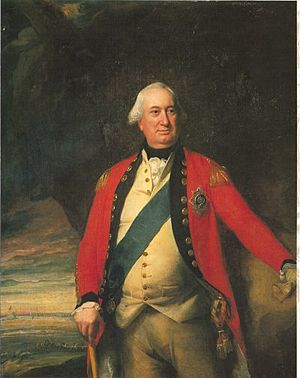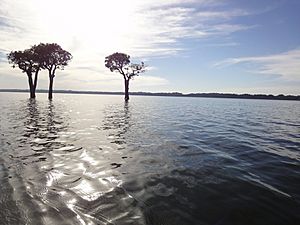Revolt of Radharam facts for kids
The Revolt of Radharam, also known as the Chargola Uprising of 1786 or the Pratapgarh Rebellion, was a rebellion against the East India Company in 1786. It was led by Radharam, a local landowner (called a Zamindar) from Chargola, in what is now Assam, India. This revolt was one of the first fights against British power in Northeast India.
Contents
Why Radharam Rebelled
The story of the revolt begins in the 1760s. Radharam Datta, a businessman from the village of Taltala, settled in Chargola. This area was located where Sylhet, Tripura, and the Mizo Hills met. Chargola was part of the lands owned by Ghulam Ali Choudhury, the Zamindar of Pratapgarh.
Radharam ran a very successful business there. He sold many goods and supplies. One of his main customers was the Zamindar himself. Radharam often sold things to Choudhury on credit when he didn't have money. He also loaned money to the Zamindar.
As Choudhury's debts grew, he promised Radharam more and more land from his estate as payment. When Ghulam Ali Choudhury passed away, Radharam expected to inherit a large part of his lands.
The Court's Decision
However, the Zamindar's son, Ghulam Raja Choudhury, believed Radharam had tricked his father. He went to the British court in Calcutta to challenge the inheritance. The court decided in favor of Choudhury. It split the Pratapgarh lands, giving half to Ghulam Raja and half to Radharam. Radharam was very angry about this decision. Many believe his dislike for the British started at this point.
Radharam's Growing Power
Even after losing some land, Radharam's power continued to grow. He had strong connections with Kuki chieftains, who were important customers. He also gave jobs to members of their tribes. This helped him gain control and influence over Kuki villages.
Radharam used this influence to create his own armed group, a personal army. His son, Ranamangal, led this group. Radharam also gained favor with Durga Manikya, the Maharaja of Tripura. The Maharaja gave him the right to govern Chargola as its Zamindar. Radharam built his own fort, courts, and even a prison. He ruled like an independent chief, and people in his lands called him Nawab, which means a powerful ruler.
The Rebellion Begins
Since 1765, the East India Company had gained control over tax collection in Bengal. This meant all landowners had to register with the Company. New rules were made for land ownership, including the "Permanent Settlement" under Lord Cornwallis. Radharam refused to follow the Company's rules. He declared himself the independent Nawab of Chargola.
When Radharam heard that Ghulam Raja Choudhury had registered his own lands with the British, he became furious. He decided to punish Choudhury. Radharam began using his armed group to take control of parts of Pratapgarh. His goal was to remove Choudhury from his lands completely.
Attacks and British Response
Kuki soldiers from Radharam's army attacked Choudhury at his family home. Choudhury survived, but many people were hurt. Choudhury and other local Zamindars who faced similar attacks complained to the British. Robert Lindsay, the British District Collector of Sylhet, set up a police outpost near Chargola. This was meant to keep Radharam in check.
A few months later, in 1786, Radharam ordered an attack on the outpost. Its inhabitants were killed. Radharam then built a new fort there, manned by his Kuki soldiers. The British then placed a war-boat in the nearby Son Beel lake. However, this boat was also attacked, and all the soldiers (called sepoys) on board were killed.
The Battle of Son Beel
After a second failed attempt to stop Radharam, Lindsay sent a fleet of war-boats to attack Chargola. A battle on the Son Beel lake lasted for several days. At the same time, the Company sent an army of foot soldiers to attack from another direction. Radharam's son and commander, Ranamangal, was killed in this fight. His soldiers then fled.
The British occupied Chargola and captured Radharam's three other sons. However, Radharam himself managed to escape.
After the Rebellion
Radharam avoided capture for several months. He was finally arrested while in disguise at a religious festival. Chargola was first given to Ghulam Raja Choudhury. But later, it was returned to Radharam's sons after they promised loyalty to the Company. The land was divided into three parts among them. Only the eldest son, Jaymangmal, was recognized as the Zamindar. The estate then became permanently settled under British rule in the Bengal Presidency.
Radharam became a legendary figure in the Barak Valley. His revolt is seen as a brave defense against the expanding British power. He is remembered in local stories as a hero who fought for freedom. Tales of his actions and the rebellion are still told today in folktales and songs among rural communities.
See also
- Pratapgarh Kingdom
Images for kids





